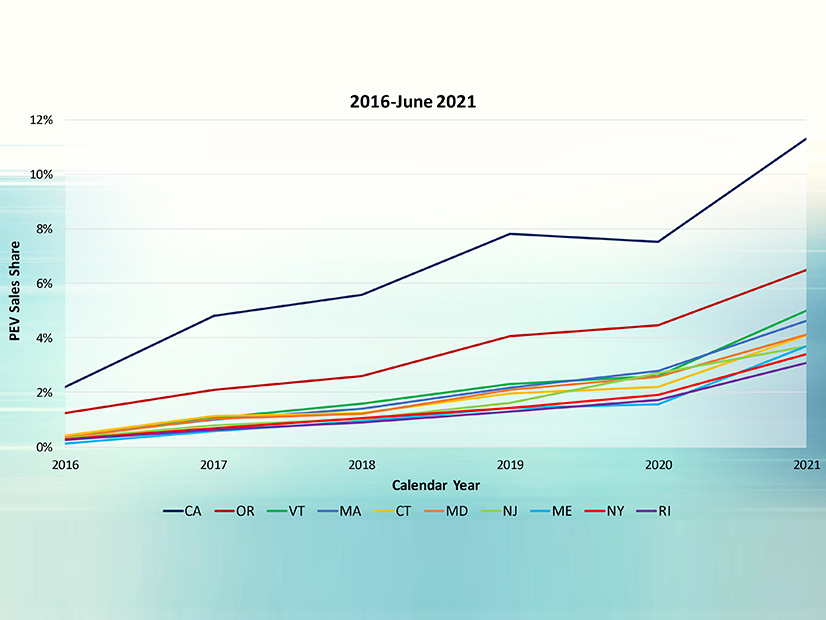
Car manufacturers selling vehicles in states that follow California’s zero-emission vehicle regulations would be able to transfer ZEV credits among states under a new proposal from the California Air Resources Board (CARB).
The proposal is part of the Advanced Clean Cars II regulation, which CARB is developing as an update to Advanced Clean Cars rules now in effect. CARB staff discussed the proposal during a workshop on Wednesday.
Under the proposal, transfers between states would be allowed for ZEV credits generated in model years 2026 through 2030.
An automaker would be able to transfer credits earned in one state to another state after the credit requirement in the initial state is met. For model year 2026, transferred credits could be used to satisfy up to 15% of a state’s ZEV requirement. The percentage allowed would decrease each year, dropping to 10% in model year 2030.
Credits from model years 2025 and earlier would not be eligible for transfer, nor would credits from a newly proposed environmental justice ZEV credit.
CARB said the idea behind the credit transfer allowance is to provide “flexibility to address varying needs and circumstances” of the different states “by giving automakers flexibility in the early years while ensuring sales ramp up to levels needed to achieve the states’ climate and air quality goals.”
The ZEV program is one part of Advanced Clean Cars; the regulation also includes a low-emission vehicle program that sets standards for vehicle emissions.
The ZEV program requires car manufacturers to earn a certain number of credits each year by providing zero-emission vehicles, such as battery-electric vehicles or fuel-cell electric vehicles, for sale in the state. Sales of plug-in hybrid electric vehicles also earn credit.
The goal is to increase the availability of ZEVs to car buyers. Twelve states so far have adopted California’s ZEV program, and several other states may soon follow suit.
Durability Standards
Advanced Clean Cars II will also include durability requirements for ZEVs.
CARB has proposed a requirement for battery-electric vehicles and fuel-cell electric vehicles to be designed to maintain 80% of their range for 10 years or 150,000 miles. That’s a change from an earlier proposal for maintaining 80% range at 15 years or 150,000 miles.
To check compliance, CARB would have authority to procure and test in-use vehicles that haven’t had an “excessive” amount of fast-charging or vehicle-to-grid operation.
Another proposed requirement would set a minimum warranty period of eight years or 100,000 miles for batteries, with warranty failure occurring when the battery falls below 80% of “state of health.”
CARB staff acknowledged that more stringent durability requirements could lead to higher costs for ZEVs.
In addition, a number of factors outside a manufacturer’s control may contribute to range degradation, CARB staff noted. Those include a vehicle owner’s charging and driving behavior, average ambient temperature and battery age.
EJ Credits Modified
CARB staff is also fine-tuning a proposal for environmental justice (EJ) credits in the ZEV program. The agency introduced the concept of EJ credits during a workshop in August. (See CARB Plan Aims to Broaden Access to ZEVs.)
The proposal would provide EJ credits to automakers that sell electric vehicles at a discount to community programs offering services such as ZEV car sharing. As proposed in August, the level of discount required to receive a credit would be based on the manufacturer’s suggested retail price for the vehicle, maxing out at 25%.
CARB’s latest proposal simplifies the discount requirement, setting it to a minimum of 25% for any vehicle sold to a community program. The program must serve low-income or disadvantaged communities.
Another way a car maker could earn an EJ credit would be by keeping ZEVs in California after their lease expires, thereby increasing the state’s supply of used ZEVs. As proposed in August, the credit would be available only to zero-emission vehicles; CARB’s latest proposal now includes ZEVs and plug-in hybrid electric vehicles.
The new proposal also adds a requirement that the used car be registered to a qualifying low-income household in California.
An automaker could use the optional EJ credits to increase the number of ZEV credits they receive for a particular vehicle. EJ credits for a single vehicle would range from 0.2 to 0.5.
The EJ credits would be available for model years 2026 through 2031. An automaker could use EJ credits to meet up to 5% of their ZEV credit requirement in a year.
CARB is still collecting feedback on its Advanced Clean Cars II proposals. The agency expects to present a rulemaking package to the CARB board in June 2022.
The regulations are expected to take effect starting with model year 2026.



